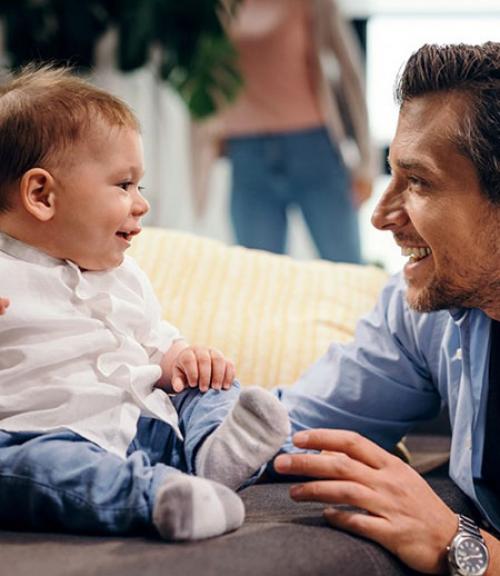Babies develop slowly and must learn pretty much everything from scratch, including how to ask for what they need. But babies are not quite as helpless as they seem, especially when it comes to language.
New research from Cornell’s Behavioral Analysis of Beginning Years (B.A.B.Y.) Laboratory reveals that baby babbling elicits profound changes in adult speech. Adults unconsciously modify their speech to include fewer unique words, shorter sentences and more one-word replies. This simplified speech happens only in response to the baby’s babbling, and not when the adult is simply talking to the baby.
The paper, “The Ecology of Prelinguistic Vocal Learning: Parents Simplify the Structure of Their Speech in Response to Babbling,” published online July 16 in the Journal of Child Language. The senior author is Michael Goldstein, associate professor of psychology in the College of Arts and Sciences and co-director of the B.A.B.Y. Lab.
“Infants are actually shaping their own learning environments in ways that make learning easier to do,” said lead author Steven Elmlinger, a doctoral candidate in the field of psychology. “We know that parents’ speech influences how infants learn – that makes sense – and that infants’ own motivations also change how they learn. But what hasn’t been studied is the link between how infants can change the parents, or just change the learning environment as a whole. That’s what we’re trying to do.”
The study brought 30 mother-infant pairs to the lab’s large play space for 30-minute sessions on two successive days. The 9- and 10-month-old babies could roam freely around the naturalistic environment, which is filled with toys, a toy box and animal posters. The babies wore denim overalls with hidden wireless microphones to record their speech, while also being videotaped by three remote-controlled digital video cameras.
In addition to measuring parents’ vocabulary and syntax, the researchers calculated the change in babies’ vocal maturity from the first to second day as reflected in the proportion of infant vocalizations with consonant-vowel structure. The researchers found that the babies whose mothers provided more learning opportunities by using simplified speech, with fewer unique words and shorter utterances, were faster learners of new speech sounds on the second day. In contrast, vocal learning in the babies was not affected by the lexical diversity of speech that wasn’t contingent on babbling.
The current study is part of an ongoing research project in the B.A.B.Y. Lab to understand infant learning and vocalizations. In previous research, Goldstein found that mothers’ verbal responses when the babies’ babbles were directed at objects were consistently different from when they were talking to each other – another example of how babies maximize their environment for learning.
The research contributes to a growing body of work that demonstrates the important role infants play in shaping their own language environment. Interventions to improve at-risk children’s learning should encourage people to be responsive to their baby’s babbling, Goldstein said.
“It’s not meaningless,” he said. “Babbling is a social catalyst for babies to get information from the adults around them.”
Responding to babbling cues also works at a distance: You can respond to a baby from across the room or even from around the corner, Goldstein said.
“This working at a distance is probably pretty important, evolutionarily speaking,” he said. “Given their extended period of helplessness, being able to communicate at a distance greatly increases opportunities for social learning.”
Also contributing was B.A.B.Y. Lab co-director Jennifer Schwade, a visiting scholar in the Department of Psychology. “Babbling has a profound effect on parents,” she said. “We are just starting to learn how babbling changes how parents talk to their infants.”
The study was supported by the National Science Foundation.
This article also appeared in the Cornell Chronicle.




